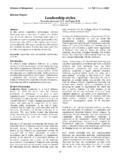Transcription of THE RELATIONSHIP BETWEEN SERVANT LEADERSHIP AND ...
1 THE RELATIONSHIP BETWEEN SERVANT LEADERSHIP AND ORGANIZATIONAL COMMITMENT A Dissertation Presented to The Faculty of Tennessee Temple University In Partial Fulfillment of the Requirements for The Degree Doctor of Philosophy By Woody D. Rimes April 2011ii THE RELATIONSHIP BETWEEN SERVANT LEADERSHIP AND ORGANIZATIONAL COMMITMENT By Woody D. Rimes APPROVED: COMMITTEE CHAIR: Andrew T. Alexson, COMMITTEE MEMBERS: Lori Robertson, Cary Kimbrell, DIRECTOR OF IN LEADERSHIP PROGRAM: Andrew T. Alexson, iv Copyright 2011 Woody D. Rimes All Rights Reserved iv ABSTRACT The results of this study revealed the RELATIONSHIP BETWEEN the pastor s SERVANT LEADERSHIP and the staff member s organizational commitment to the church. Data collected was from 37 Southern Baptist churches in the state of Mississippi with a resident membership of 500 or more.
2 Ninety-one participated in the study. Using the SERVANT LEADERSHIP Questionnaire (SLQ) (Barbuto & Wheeler, 2006), the Three-Component Model (TCM) Employee Commitment Survey (Meyer & Allen, 2004), and a demographic survey, the data was collected. Full-time ministerial staff members and administrative assistants participated, rating the SERVANT LEADERSHIP style of their pastor in addition to providing their organizational commitment. Evidence supported the reliability and validity of both SERVANT LEADERSHIP and organizational commitment models and the associated instruments. This study found a statistically significant correlation BETWEEN the pastor s SERVANT LEADERSHIP style of LEADERSHIP and the staff s affective and normative organizational commitment. No statistical significant correlation existed BETWEEN the pastor s SERVANT LEADERSHIP style of LEADERSHIP and the staff s continuance commitment to the organization.
3 Statistical data and implications for the findings were included. This research presented information that can be used in future studies relating to LEADERSHIP behavior, as outlined in SERVANT LEADERSHIP theories and its effect on subordinates in DEDICATION This dissertation is dedicated to Julie, who is my beautiful wife, who is my best friend, who has encouraged time and time again, who has prayed for me, who has stood beside me, who has been longsuffering with me, who loves God, who is a great mother to our children, who is a wonderful Lalie to our grandchildren, who is a shining light for our Great God. vi ACKNOWLEDGEMENTS First, I would like to thank my chair, Dr. Andrew T. Alexson, for making this such a meaningful process for me. His guidance and encouragement has been invaluable. His time spent coaching me and helping me to formulate the ideas has been priceless.
4 He has offered a critical and keen insight, which has helped in the success of this research project. I would also like to thank Dr. Jerry Hall for the initial motivation and encouragement to start the journey at Tennessee Temple University. I am also very thankful for Dr. Lori Robertson and Dr. Cary Kimbrell for their encouragement and their participation on my committee. I am grateful to my family for their prayers, understanding, and encouragement during the years of my education. Most of all, I give thanks to my wife, Julie, who has sacrificed the most for me during these recent years of doctoral study. Ultimately, I give thanks to my Lord and Savior, Jesus Christ. He has been my Strength, Hope, and He is my Redeemer. It is my prayer that this work will bring glory to His Holy Table of Contents ii Table of Chapter 1: Introduction to the Study .. 1 Background of the Study.
5 1 Statement of the Problem .. 3 Research Questions .. 4 Significance of the Study .. 4 Overview of Methodology .. 5 6 Organization of Study .. 8 Chapter 2: Review of Literature .. 9 LEADERSHIP .. 9 Types of LEADERSHIP .. 12 Trait Approach .. 12 Style Approach .. 12 Contingency Theory .. 14viii Situational Approach .. 15 Path Goal Theory .. 16 Leader Member Exchange Theory .. 17 Transactional LEADERSHIP Theory .. 18 Transformational LEADERSHIP .. 18 SERVANT LEADERSHIP .. 19 Areas of SERVANT LEADERSHIP .. 28 28 Education .. 29 Christian Ministry .. 29 30 Organizational Commitment .. 31 Summary of Literature .. 38 Chapter 3: Methodology .. 40 Research Perspective .. 42 Ethical Consideration .. 43 The Research Participants .. 43 Instruments Used in Data Collection .. 44 SERVANT LEADERSHIP .. 44 Organizational Commitment .. 46ix Procedures Used .. 49 Data Collection.
6 53 Data Analysis .. 53 Summary of the Methodology .. 54 Chapter 4: Report of the Findings .. 55 Introduction .. 55 Demographics of Survey Study Participants .. 55 56 Age .. 57 Marital 57 Education .. 58 Tenure with Present Church .. 59 Position with Present Church .. 59 Reliability .. 60 Cronbach s Alpha Reliability Scores for SLQ Survey .. 60 Cronbach s Alpha Reliability Scores for TCM Employee Commitment Survey .. 62 Descriptive Statistics .. 64 Results of the Correlation Analysis .. 67 Research Question 1 .. 68 Research Question 2 .. 69x Research Question 3 .. 70 Summary .. 70 Chapter 5 Summary, Recommendations and 72 Purpose .. 72 Implication of the Findings .. 75 Research Findings 1 .. 75 Research Findings 2 .. 76 Research Findings 3 .. 78 Limitations .. 82 Recommendations for Future Research .. 83 Conclusion .. 83 REFERENCES .. 86 Appendices .. 102 Appendix A.
7 102 Appendix B .. 103 Appendix C .. 104 Appendix D .. 105 Appendix E .. 106 Appendix 107 Appendix G .. 108 SERVANT LEADERSHIP and Organizational Commitment 1 Chapter 1: Introduction to the Study In this chapter, the researcher discussed the correlation BETWEEN the SERVANT LEADERSHIP of the pastor and organizational commitment of the staff. A statement of the problem, the research questions and the hypotheses were presented. The researcher also included in the significance of the study, overview of methodology, definitions and the further organization of the study in this chapter. Background of the Study Today s world is more turbulent, chaotic, and challenging than ever before (Kanter, 1995). Organizational changes were becoming increasingly a major component of everyday organizational life. The basic principles of ministry were changing fundamentally. One major challenge for the environment was a shortage of skilled, competent, and committed employees.
8 The competitive edge of companies no longer relied on its product, but in its people (Ulrich, 2002). People were the lifeblood of organizations, and they represented the most potent and valuable resources of organizations (Gunnigle, Heraty & Morley, 1971). The days when leaders controlled, dominated, and manipulated organizations at their pleasure are over (Block, 1993). Bhindi and Duigna (1997) noted that LEADERSHIP was being redefined. The new LEADERSHIP focused more on service and stewardship rather than remaining a system of controls and procedures. Sauter (1996) defined healthy workplaces as any organization that maximizes the integration of worker goals for well-being and company objectives for profitability and productivity . According to this definition, components for a healthy organization included both the organization and the individuals SERVANT LEADERSHIP and Organizational Commitment 2 within the organization.
9 Ulrich (2000) referred to people as intangible resources, which were difficult to imitate. Therefore, the commitment of competent employees was critical to the success of the organization. The church was one organization that consisted of leaders and employees. In the church s organizational life, God called the pastor to preach and to minister to His people. God bestowed a great honor on a man when He called him to be a pastor (Cothen, 1981). The pastor s call was for the advancement of the kingdom of God. The pastor had the responsibility to lead, not only the church, but also the ministerial staff. It was important for the pastor to understand his impact on other staff members. While the pastor s role had changed in the church, ministerial staff came to realize the importance of their role of ministering to people in the church. For staff members to minister to the church members, they needed to build relationships with those inside the church.
10 Staff members needed to be willing to be committed to the church they were serving if they desired to build relationships. Effective staff members must be committed to the purpose, vision, and values of the church they are serving (McIntosh, 2000). It was important for the pastor to have a healthy RELATIONSHIP with his staff members. Some of the greatest challenges faced by a pastor were not with the congregation, but rather with the staff. Conflicts BETWEEN pastors and staff had the potential to disrupt the overall vision and ministry of the church. Due to their position, pastors were parties to every major church conflict, and paid church staff was frequently involved, as well (Halverstadt, 1991). Pastors should spend time nurturing and leading staff members. In most situations, when the pastor intentionally nurtured the staff, the development of a strong staff would take place (McIntosh, 2000).









